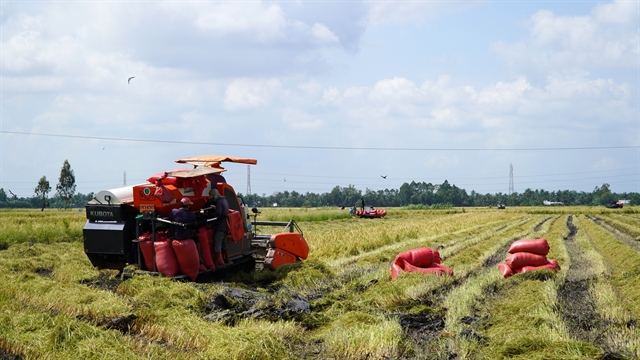 Society
Society

 |
| Farmers in Long Thạnh Commune in Kiên Giang Province’s Giồng Riềng District harvest the 2023 autumn-winter rice. – VNA/VNS Photo Văn Sĩ |
KIÊN GIANG – The Cửu Long (Mekong) Delta province of Kiên Giang is expanding organic rice farming and developing linkages between various stakeholders in the value chain.
The country’s largest rice producing province is targeting 6,500ha in An Minh, An Biên and Vĩnh Thuận districts and an annual output of 31,900 tonnes by 2025.
By 2030 it plans to expand the organic rice area to 25,000ha in the three districts and also U Minh Thượng, Gò Quao and Hòn Đất, and output to 129,185 tonnes.
Lê Hữu Toàn, deputy director of the province Department of Agriculture and Rural Development, said organic rice cultivation would increase added value, enable sustainability, help implement the country’s target programmes, and promote the province’s potential.
The province is set to pioneer the development of organic rice, seamlessly blending environmental preservation and bio-diversity enhancement, according to the official.
The strategy involves a substantial increase in the adoption of organic farming methods, incorporating elements such as organic pesticides and fertilisers.
Extensive efforts will be made to disseminate organic rice farming techniques among growers, equipping them with the skills to efficiently manage cultivation and rice processing.
Stringent inspections of certified organic rice-growing models will continue, ensuring compliance with the highest standards.
Small-scale enterprises, co-operatives, and household units demonstrating the capability to produce organic rice will be carefully selected and connected with relevant stakeholders to participate in various models.
Infrastructure investments in designated organic rice areas will prioritise advanced farming techniques, focusing on key components like irrigation systems, pumping stations, power infrastructure, roads, warehouses, rice dryers, and processing facilities.
A meticulous approach to managing the quality of materials used in organic rice cultivation and the usage of organic brand names will secure quality.
The province will actively promote collaborative ties among farmers, companies, scientists, and local authorities to foster the production of organic rice.
Cultivating Quality Rice
Kiên Giang has joined a Ministry of Agriculture and Rural Development project aimed at cultivating one million hectares of high-quality, low-emissions rice aligning with green growth goals in the Mekong Delta until 2030.
In the current winter-spring rice season, the province plans to cultivate 60,000 hectares under this initiative, with the participation of over 100 co-operatives.
These co-operatives meet three key criteria: simultaneous sowing of certified seeds, adopting the "one must - five reductions" method and strengthening partnerships with companies to secure outlets.
The "one must - five reductions" method prioritises certified seeds while minimising the use of seedlings, nitrogenous fertilisers, plant-protection chemicals, and irrigation and post-harvest losses.
The province aims to cultivate 279,000 hectares of winter-spring rice, with high-quality varieties to constitute over 95 per cent of total yield.
A cautionary note advises farmers to complete sowing before year-end to avoid water shortages.
Significant focus is directed towards the development of large-scale rice fields, creating favourable conditions for partnerships between companies and farmers.
More than 1,300 large-scale rice fields pooling a total area of 167,225 hectares have been established, more than double last year's count.
There are also 300 rice-growing areas totalling over 6,000ha with production codes for export to markets including the EU and Japan.
The province has embraced information technology for disease monitoring and equipped farmers with advanced agricultural techniques.
Collaborating with localities, its irrigation sub-departments have implemented co-ordinated measures to combat drought and saltwater intrusion, safeguarding water meant for agriculture, including the 2023-24 winter-spring crop.
Infrastructure enhancements encompass construction of and upgrades to saltwater prevention dams, irrigation sluices and electric pumping stations, canal dredging, and repairs, ensuring effective operation, particularly the Cái Lớn-Cái Bé irrigation sluice system, the delta's largest.
In the previous autumn-winter season farmers in the province enjoyed bumper harvests and high selling prices, and made profits of VNĐ20-25 million ($800-1,000) per hectare.
Across Giồng Riềng, Gò Quao, Châu Thành, Tân Hiệp, Hòn Đất, and Giang Thành districts, over 90,000 hectares produced an average yield of 5.7 tonnes per hectare.
Danh Phương in Giồng Riềng District’s Bàn Thạch Commune said in 2022 autumn-winter he did not grow any rice, but this year he grew two hectares of Đài Thơm 8 rice because of favourable weather forecasts and high prices.
“At the start of the season, traders paid an advance for rice at a rate of VNĐ8,500 per kilogramme, nearly double the price of the 2022 autumn-winter crop.
“Recognising the profit potential, I signed a sales contract with a trader early.” – VNS




